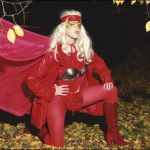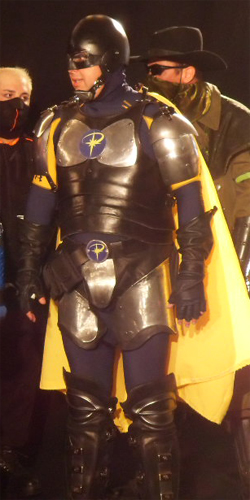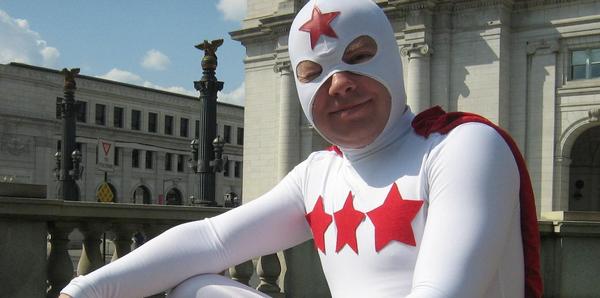
Life: Seeks out injustice to right wrongs - though it's more about helping the homeless than fighting bad guys
Originally published:
http://www.independent.co.uk/arts-entertainment/films/features/holy-masked-avengers-meet-the-reallife-superheroes-1932467.html
Thwack! Pow! Take that, evil agents of the clamping industry! Here’s a toothbrush, my homeless friend! As the wannabe-superhero film ‘Kick-Ass’ hits cinemas this weekend, Johnny Davis catches up with the real-life caped crusaders who are striving to do good on the mean streets of Britain and America, supported by their long-suffering families (and unforgiving spandex…)
Sunday, 4 April 2010
On a Thursday evening in New York City, Chaim “Life” Lazaros is explaining how a 25-year-old film student becomes a Real Life Superhero. “When I’m dressed the way I am, I’m standing for a higher ideal,” he says. Lazaros is wearing a domino mask, fedora and skinny black tie. From the corners of his waistcoat hang the fringes of a tsitsit – a traditional Jewish undergarment. “By becoming a Real Life Superhero, I can no longer fall to the weakness or the laziness Chaim might have. I live for a higher, stronger, ideal. I have to live up to what Life is.”
As is his wont several times a week, Lazaros has returned to his Upper West Side apartment and exchanged the clothes he wears to class for those of his alter ego. He has become Life (the English translation of the Hebrew word chaim). Now there are good deeds to be done, injustices to be fought, wrongs that must be righted. “Being a Real Life Superhero is an extremely individual calling.”
Yet Lazaros is not alone. There are, according to the recently launched World Superhero Registry, more than 200 men and a few women who dress up as comic-book heroes to patrol their city streets in search of… if not supervillains, then petty criminals and those in need of their help. “I help my community to become better,” Life tells me. “I didn’t see people running out of banks with sacks with dollar signs on them; but there is a large homeless population who need things.”
Soon he will walk half a block to the cathedral of St John the Divine, a vast gothic structure where vagrants gather on the steps. “Private property, so the police can’t chuck them off,” he explains. There, Life will hand out bottled water, toothbrushes, vitamins, chocolate and other items he carries around in his backpack. He does this without ulterior motive. “I’m not trying to convert them to Christianity,” he says, referring to other charity workers. “‘Accept Jesus Christ and I’ll give you a sandwich’ – that’s not really a help.”
For the most part, Life avoids tackling criminals. “If there is a situation and I need to intervene, I’ll certainly do it. But guys in Washington Square Park selling weed to New York University kids? It’s not so terrible. If I can show someone who’s down on their luck that somebody cares about them, that’s a lot more effective use of my talent.”

Captain Clean: Teaches the children of Kent with both T-shirts and raps ('Don't drop litter on the street/It looks a mess and sticks to your feet')
Elsewhere in the metropolis, a woman named Terrifica has been patrolling bars and parties in a gold mask, Valkyrie bra, red boots and cape, in an effort to protect inebriated women from men looking to take advantage of them. (In her utility belt, she carries pepper spray, a camera to photograph would-be predators, a journal, and Smarties for energy.) In Mexico City, meanwhile, Superbarrio dons red tights and a red-and-yellow wrestling mask, using his eye-catching image to organise labour rallies and protests, and file petitions. In Iqaluit in northern Canada, Polarman shovels snow off pavements by day, and scours the streets for criminals by night. And in Britain, Angle-Grinder Man, a self-proclaimed “wheel-clamp superhero”, uses his power (his angle-grinder) to cut clamps from vehicles in Kent and London.
You might think these people sound silly and look sillier. You’d be right. But that doesn’t mean they’re not sincere. “It takes a certain mindset not just to say, ‘OK, I want to do something good,’ but also, ‘I want to take on an alternate personality and devote myself entirely to doing good with no boundaries,'” says Life. “To put yourself in an uncomfortable situation takes a huge commitment. And a certain amount of crazy.”
Life is not a Man of Steel from the planet Krypton. He isn’t a science whizz lent superhuman powers by the bite of a radioactive spider. He doesn’t live in a Batcave. Like the growing network of caped crusaders emerging across the world, he is just an ordinary person trying to make a difference. “After 9/11, a lot of people felt very confused, that they had lost control over their world,” says Ben Goldman, founder of Superheroes Anonymous, which alongside the World Superheroes Registry and Real Life Superheroes, acts as an online network where members can swap crime- fighting tips, offer encouragement and debate the pros and cons of spandex. “That event caused them to take control of their destinies and adopt a superhero persona.”
“Right now, people need heroes,” adds Life. “Economic collapse, two wars, and a president who was elected on a platform of change – with a message we were to pull ourselves up by our bootstraps from these problems. Real Life Superheroes personify those ideas and those ideals.”
Couldn’t they help another way? Join a charity, perhaps? Do they need to dress up like Zorro at Mardi Gras? “I’m well aware of how silly the situation is,” says Civitron, aka 28-year-old David Civitarese from New Bedford, Massachusetts, who picks up litter and hands out food parcels to the poor, while wearing a red-and-blue one-piece and white shades. “But by dressing up I’m forcing myself to play a role. I have the opportunity to show off the best of me. I can’t go around partying and drinking and being a jerk.” (In his civilian hours, Civitarese works in a care home for adults with autism. His six-year-old son goes by the super-moniker The Mad Owl.)
The movement’s origins might be American, but Britain is catching up. “When I heard about Real Life Superheroes, I thought it was a bunch of crazy comic geeks. The Beano was the only comic I’d ever read,” admits Optimistica from London, whose MySpace profile reverberates to the theme of Wonder Woman. “But I was won over by the amazing positivity and creativity of the superheroes.” Optimistica adds that her mission is to “spread light and fun”. “And wearing my costume on patrol alone does that.”
“People think it’s a stupid idea and want to leave it at comic-book fantasies,” says Bristol-based Red Falcon, so named after “my fave colour and bird”. “But in a world where even the police aren’t doing their jobs, someone has to step in and help.” Norwich’s Chuck Clown was similarly galvanised into action. “I became a Real Life Superhero because petty criminals had attacked people I knew. They escaped unscathed, but people should never have to escape from an attack in the first place.” Clown’s inspirations are “the original comic-book Joker, not the new Heath Ledger one – but without being mad and evil. And Jonathan Creek.”
Naturally, every superhero needs a costume (though they prefer to say “uniform”). And suppliers such as Xtreme Design FX will knock up a custom all-in-one “battle suit”, silk-lined spandex cape and latex mask for around £160 (prosthetic adhesive not included). Other superheroes prefer to handle the design themselves – like Utah’s Citizen Prime, who spent £2,500 employing an armourer to weld a sci-fi suit out of plate metal. Meantime, “master of gadgetry” Professor Widget is a one-stop shop for wrist-mounted paintball launchers or non-lethal telescoping “bo staffs”. Not that such weaponry is everyone’s cup of tea. “A lot of the time, I just keep an eye on stuff, and if anything happens I’ll step in and give someone a bollocking – verbally – or call the police,” says Clown. “A Real Life Superhero’s most important gadget is their mobile.”
Some say the emergence of Real Life Superheroes represents the final evolution of the hero genre. “Oral traditions, legends, comic books, movies – and now Real Life Superheroes bringing it into reality,” says Civitron. Superhero movies spent decades struggling to get up, up and away; now they’re among the biggest box-office draws. And the most successful – The Dark Knight, Iron Man, Watchmen – focus not on characters with otherworldly superpowers, but ordinary citizens doing extraordinary things.
The same can be said of Kick-Ass, the new film by Matthew Vaughn – the producer of Lock, Stock and Two Smoking Barrels and director of Layer Cake – which opened in cinemas this weekend. Based on the comic book of the same name, it tells the story of Dave Lizewski, an ordinary New York high-school student who fights crime in a costume he has cobbled together out of a diving suit. “How come everybody wants to be Paris Hilton, and no one wants to be Spider-Man?” ponders comics fan Lizewski, played by Aaron “Nowhere Boy” Johnson – a reasonable question, when you put it like that.
It was a comic shop that inspired the inception of Superheroes Anonymous. One afternoon, Ben Goldman spotted what he thought was a notice announcing “a meeting for superheroes”. It turned out to be an advert for drawing lessons. “But the idea stuck with me,” he says. “I decided to investigate whether there were people in the world who called themselves superheroes.” He went online, and found that there were. Thinking he had chanced upon a good subject for a documentary, he called his film-student friend Chaim. Their movie is still an ongoing project, though it’s been hit by issues both logistical (not every Real Lifer wants to be filmed) and financial (they are scattered all over the world). Yet it has already served to galvanise the cause.
Goldman and Lazaros started organising Superheroes Anonymous conferences. First, their reasons were wholly practical – getting these heroes together made them easier to film. But it wasn’t long before gathering so many altruistic people in one place turned the conferences into charity-fests. In New York, they raised $700 in gifts and distributed them to the kids at St Mary’s Children’s Hospital. In New Orleans, they rebuilt homes with Habitat For Humanity, cleaned up a school and marched against youth violence alongside Silence Is Violence. And in New Bedford, a full weekend’s programming saw them host a community food drive, working with the American Red Cross, and putting together care packages for overseas troops. (In between there was time for martial arts workouts, early-morning runs and evening meetings at the local tapas bar – in full costume, naturally.)
Superheroes Anonymous even provided Lazaros with his new identity. “Entomo the Insect-Man, an Italian Real Life Superhero, defined all the different types of hero,” he explains. “One category was ‘community crusader’; someone who furthers the goal of Real Life Superheroes.” The Insect-Man reasoned that, by “putting his all” into promoting Superheroes Anonymous, Lazaros had “become a superhero” himself. “The day I read that, I put on the mask for the first time.” Life was born.
Today, we are sat on the stoop outside Life’s apartment block. He has been joined by an acquaintance, Dayo Omotoso. Omotoso is a Real Life Superhero in training, and Life is showing him the ropes. He has got as far as his name: The Black Light. “If you want to be a hero, your name can’t be Dracula,” Life reasons. “Your name can’t be Captain Chaos.” Omotoso is still thinking about a costume.
“We gotta go,” Life announces, suddenly.

Together, we walk down to the cathedral of St John the Divine. Life tells us to hang back, and goes off to distribute his waters and vitamins among the homeless. As we watch him work, I find out more about The Black Light. He was born in Nigeria, and came to New York a few years ago. In doing so, he seems to have taken Superman’s edict about “truth, justice and the American way” on board. “In 20 years in Lagos I never called [the local equivalent of the American emergency services] 911 once,” he says. “You’re not inclined to, psychologically. I’ve been under a regime where my president passes away – it was Viagra overdoses and prostitutes [the alleged transgressions of Sani Abacha, de facto Nigerian president between 1993 and 1998]. When I came here, the Monica Lewinsky thing was still going on. My angle was, ‘Did he rape her? Did he put money into a bank account for her?’ No, he just got a blowjob. If any guy in the world deserves a blowjob, it’s Clinton.”
America sounded like somewhere he could make a difference, he said. “I’ve seen Tom Cruise, I’ve seen the Governator, I’ve seen Chuck Norris. I grew up reading The Punisher. When it comes to saving the human race, I would love a black guy to play that role.”
As anyone with a passing knowledge of Spider-Man knows, being a superhero requires great personal sacrifice. The path will be rocky, the way forward strewn with obstacles. Not everyone will make it. Take Mister Invisible from Los Angeles. He hung up his grey one-piece after the costume proved too effective – a tramp urinated on him in an alley. Another LA operative, Black Owl, suffered the ignominy of being collected from a psychiatric ward by his teenage daughter. “Dad forgot for a moment, when faced with police, that he did not have real superpowers,” she told doctors. “He could not just fly away.”
Then there are relationships. Apparently, women find it hard to relate to the higher calling. Interviewed by Rolling Stone, Master Legend – a Florida-based superhero who drives “The Battle Truck”, a 1986 Nissan pick-up with his initials spray-painted on the bonnet, the better to announce the arrival of himself plus his young crime-fighting sidekick Ace Gauge – conceded that his love life had taken a battering. His marriage had ended in divorce, while his latest girlfriend had walked out on him. “She left because she wanted to sit around on the couch and hold hands,” he explained. “Well, that’s not on the cards for Master Legend.”
Finally, there is the issue of the authorities. “I’ve been told by the police that any sort of uniformed presence is a deterrent to crime. It doesn’t matter if you’re wearing the uniform of a police officer or a superhero,” explains Life. In America, even attempting a citizen’s arrest itself carries the risk of being liable for false imprisonment, or being charged with kidnapping. And that’s if you don’t get punched in the face first. (As seen in Kick-Ass, when the eponymous ‘ hero’s first criminal intervention does not go too well.) “We don’t live in a city called Gotham,” notes Goldman. “We don’t encourage people to go out and look for violent criminals.” (A spokesperson for the UK police service declined to comment on the Real Life movement here, save to say that “vigilantism is not something we encourage”.)
But perhaps the most cautionary tale of all is that of Dark Guardian. He had to resort to first a change of name, then emblazoning his initials on the front of his costume, as he had failed to make much of an impact on anyone. “This is New York,” explained the newly monikered Chris Guardian. “So half the people didn’t even look.”
Failing to make an impression is not a problem faced by Maidstone’s Captain Clean. But then, his target audience is seven years old. He is employed by Maidstone Borough Council to spread the word about littering. It is the morning-time in Ms Tanner’s class at Harrietsham primary school in Kent, but Ms Tanner is taking a back seat while Alison Sollis, education officer for the council, mans the projector. Behind her hangs a poster
of Captain Clean, who wears a purple mask and a high-visibility jacket. “Keep it Clean!” it advises, “Or I Get Mean!” Sollis kicks off the lesson by asking the children to guess how long various bits of litter (banana skins, soft-drink cans) take to decompose, and explains how the British Hedgehog Preservation Society got McDonald’s to shrink the size of its McFlurry lids; the original containers could trap the critters. Then she holds up a plastic ring holder from a four-pack.
“What do you put in here?” she asks.
“Beer!” says one boy.
“Well, cans,” confirms Sollis.
Soon it is time to meet Captain Clean. “Let’s see who’s outside,” Sollis says. In bounds Captain Clean, aka bodybuilder Tai Tokes Ayoola who speaks with an American twang and seems on a completely different scale to the classroom. The children are stunned. “I think I shocked you all!” he beams. Captain Clean asks everyone to join in with his anti-littering campaign, leads them through a rap (“Don’t drop litter on the street/It looks a mess and sticks to your feet…”) and hands out his “Keep it Clean” T-shirts. Everyone applauds.
Over coffee in the staffroom afterwards, Annika Fraser, marketing officer for Maidstone council, explains Captain Clean’s secret origin. One of her colleagues had been the original Captain Clean. “But he wasn’t muscly or anything, so I had to go out and buy a costume with muscles.” It didn’t really work. “After a year, it got quite smelly.”
“The kids were rugby-tackling him,” Ayoola chimes in. “Wearing that puffed-up old thing.”
So Ayoola was recruited. Originally from Maryland, he had a history of volunteer work – notably dressing up as a superhero to take young burns survivors on summer camp. For his troubles, he had even been invited to the White House. Anyway, he had proven a much more suitable Captain Clean. “I get a lot of questions,” Ayoola says. “Particularly ‘What’s under the mask?’ But I have never had anyone be mean to me. Kids are, like, ‘OK, I don’t want to be on Captain Clean’s bad side.’ I wouldn’t say it’s an element of fear. But you do have that element of ‘OK, he’s doing this – he’s cool.'”
Ayoola is proud to be doing good work, and is up to speed with the Real Life movement. “When people see a Real Life Superhero, they get excited and follow through with the message,” he says. He has two more classes to visit this morning, so I leave him to it. “You keep it clean!” he booms after me.
Back to New York, where Life has finished his rounds of the homeless. The Dark Light is suitably impressed; give it another month, he figures, and he’ll be active himself. Meanwhile, Life says he has big hopes for the global movement. Recruitment is on the up, and MTV has been developing a series based on their work. “I think it will become very big,” Life says. “I hope there’ll be a Real Life Superhero in every city, someone everyone knows. ‘Hey, there’s someone here who can help me.’ I’m not talking about police, fire, ambulance. But people who are standing for this higher level of altruism.”
Their next step is to get Superheroes Anonymous recognised as a non-profit organisation and a registered charity. To make it more formal. Life explains that it is part of the reason his costume is on the sober side. “I’m trying to sit down with government officials, business people, lawyers; trying to make these meetings happen. I need to look at them with a straight face and say, ‘Listen, I want to bring a whole bunch of Real Life Superheroes together in your property,’ and not get laughed out of the room.”
“You do get the occasional snigger,” he concedes. “But that’s through misunderstanding. Once you explain what you stand for, there is never a negative reaction. People are always, like, ‘Wow. That’s cool. How can I get involved?'”
Or as Kick-Ass himself puts it, “Is everyday life really so exciting? Are schools and offices so thrilling that I’m the only one who ever fantasised about this? Come on – be honest with yourself. At some point in our lives, we all wanted to be a superhero.” And what’s so funny about that?
‘Kick-Ass’ (15) is on general release






















